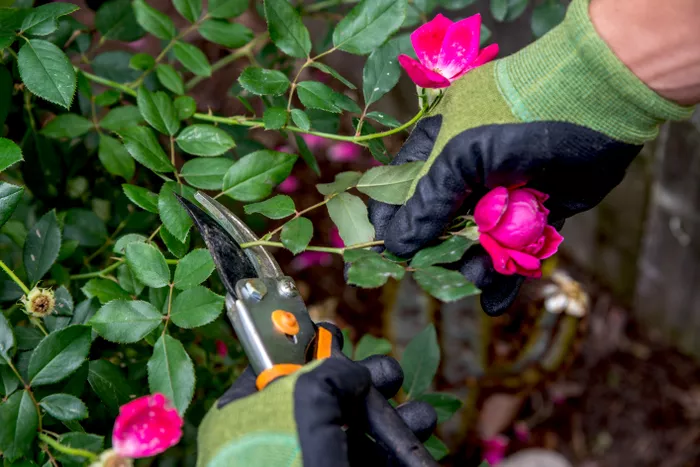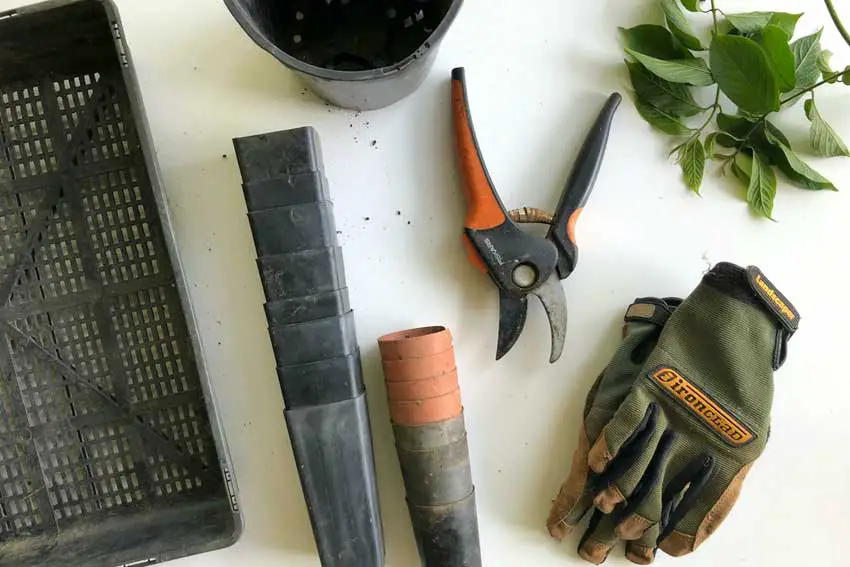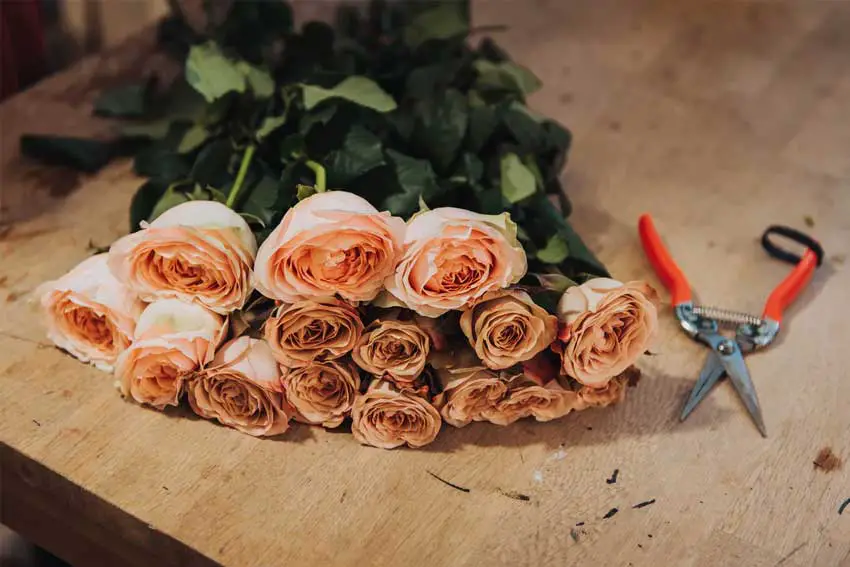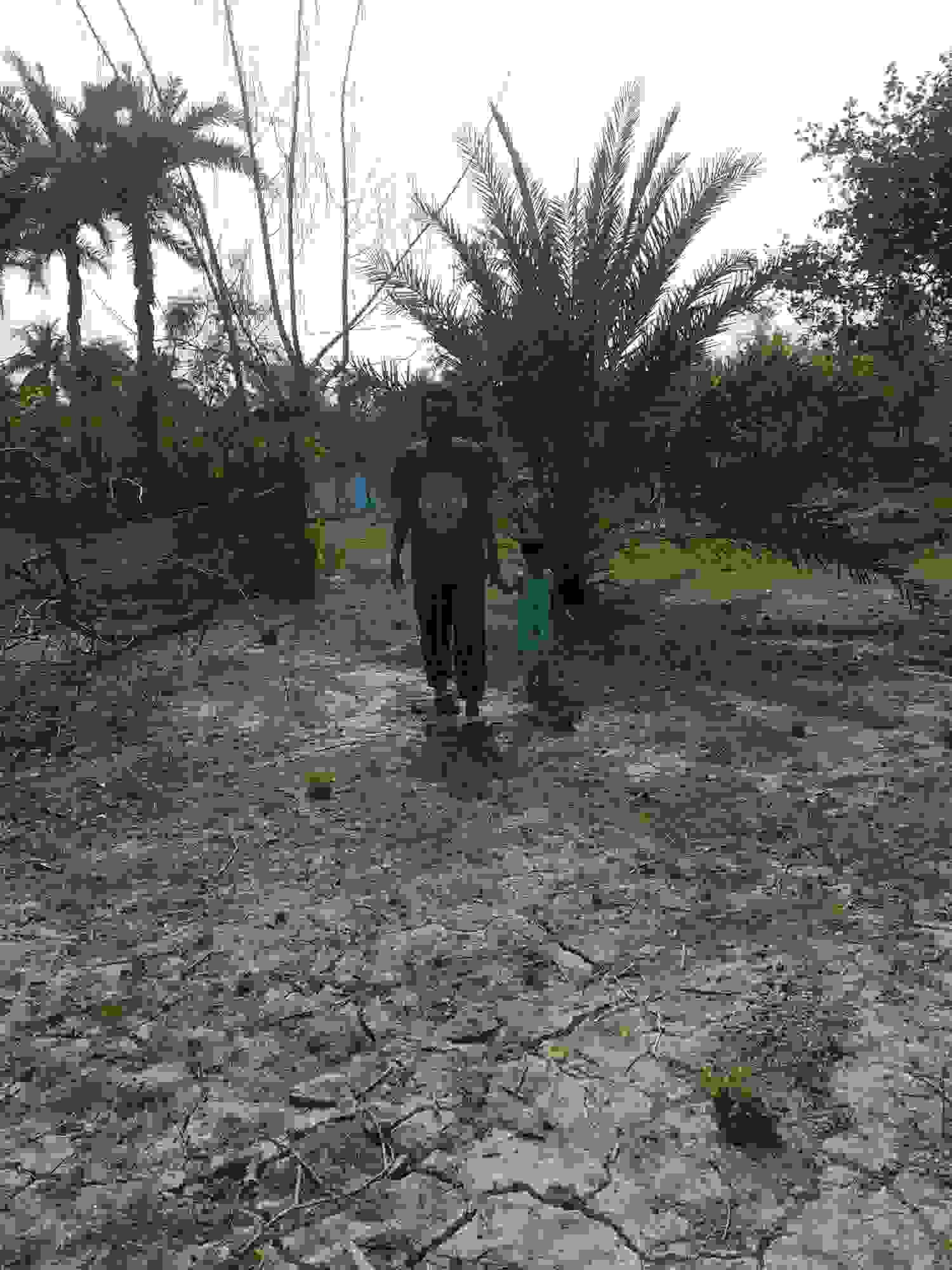Pruning is one of the most critical maintenance tasks you can execute on your rose bush. Pruning out of control rose bush, properly, enhances its growth and vitality, facilitates better blooming, and protects to prevent from mites and other insects.
Pruning is equally vital to proper soil, fertilizing, and watering for blooming hybrid tea roses or floribundas. Pruning chores include deadheading, cutting off old/dead wood, removing diseased material, and severe pruning to revitalize the plant.
Each may occur at different periods during the growing season. Still, they all serve the same purpose: opening up the shrub to enable enhanced air circulation, virus or bacteria protection, and new growth.
Steps of Pruning Out Rose Bushes

There are some necessary steps to pruning out rose bushes and eradicating mites, infections, and hazardous micro-bacterial elements that damage the bushes.
Step 1: Remove any dead leaves or whatever the leaves get paled. Because it minimizes the growth of the shrubs and kills any insects or pathogens that may be lurking on the leaves
Step 2: Prune to free up the plant’s core; crossing branches need to be eliminated. It allows for improved proper ventilation in the plant’s center
Step 3: Get rid of any dead or rotten timber. Remove the dead brown stems until you have greenish and better-growing stems. You need to take care of the young green stem from the rose bush, and the old brown stems need to be trimmed away
Step 4: Trim any stray twiggy branches. Remove any stems that are much thinner than the others

Step 5: Eliminate any of the exploiter growth. Exploiters are stems that sprout from the base of the main branches and are entirely trashy
Step 6: When you’ve trimmed all of them perished, trashy, exploiter, and twiggy branches, you may trim off a lot more, up to a third of the plant, to provide access to the interior. Here’s the finished rosebush, with around one-third of the stems removed
Step 7: Cover the new incisions and enclose freshly trimmed stems (like for multiple rose buds) with white glue to remove rot and rose borers

Step 8: Clear the whole space. Throw off any trimmed branches and leaves to avoid residual insects or pathogens
Types of Pruning Out of Control Rose Bush Depending on Time
In The First Year
roses are those that have accomplished their first blooming phase. Throughout this time, your bush constantly grows roots to strengthen the basement for subsequent flourishing. Somewhat as reason, albeit minor pruning is requisite at this stage.
Step 1: Trim the blooming branches and any excessive stems disproportionate to the entire plant by about 3-5 inches
Step 2: Remove any perished, trashy, exploiter, and twiggy stems
Step 3: Remove any leftover weeds. It’s wherever pathogen spores may stay latent, waiting to infect your plant the following season
Second Year
Your bush is actively growing its root process and is not yet perfect in size or form.
Step 1: Trim all stems by one-third as before. Trim whatever exceedingly long stems back to a similar length with the entirety of your bush
Step 2: Remove any perished, trashy, exploiter, and twiggy stems
Step 3: Remove any leftover weeds. It’s wherever pathogen spores may still be latent

Third Year
Your rose will be a fully established plant in the Third Year. Your options regarding whether substantially you trim down are usually a bit more open. Now you can control the structure and layout of your shrub.
Select one of those as mentioned earlier before pruning:
Trim down by less than one-third for a taller bush. Cut your bush down by one-third to keep its existing shape.
To lessen its size, trim it in half or further. It could minimize the shrub’s size without affecting the number of flowers. Then follow the previous steps appropriately to prune out and shape the shrub.
Fourth Year
Beyond the Fourth Yea, you are recommended to repeat the techniques in the third year to ensure your rose blooms optimally.
Necessary Elements of Pruning Rose Bush

- High-quality hand gloves: Gauntlet-style gloves are suggested for additional protection up to your hand
- Use shears instead of an anvil: Anvil blades meet and can shatter or weaken stems; shear blades cross and perform a clean cutting
- Long substantial sleeves: Wearing the proper attire will save you from getting poked or hurt by the spikes
- Lopper: Loppers often feature long handles that make cutting thick stems simpler. Bypass loppers are incredibly beneficial. Loppers exist in various sizes, so experiment with a few before investing in one
- Pruning saws: Pruning saws make it simple to trim almost anything. Pruning saws feature wooden handles, and some versions include a handle into which the blade folds for safekeeping
- Alcohol: Before working on each plant, clean your shears by immersing the blades in alcohol. It prevents bushes from proliferating by infection
When to Prune Rose Bush

Roses are found in over 150 different kinds and hundreds of hybrids. Pruning times might vary depending on the type of rose bushes you plant (say, the twilight zone & ebb tide types) and the environment it grows.
Roses bushes should be pruned in late winter or early spring, just before new growth begins. Depending on your weather, this might be as early as January or as late as May.
Here are some regional estimates to mark your calendar or make yourself a trimming reminder:
- May in Zones 3 and 4
- March or April in Zones 5, 6, and 7
- February or March in Zone 8
- January or February in Zone 9
- January in Zone 10
Spring: The first substantial rose trimming is usually done in the spring, while the first flowers appear. Whenever you prune, make sure the last hard cold winter has passed.
Summer: Deadheading can be done whenever required throughout the summer growing season. It will promote recurrent blooming and a beautiful appearance for the plant.
Fall: Cut longer stems and branches cross each other after the first winter. Get rid of any sick leaves or twigs.
3 Ways of Pruning Rose Bush
Spring Structural Pruning: It is typically undertaken after the risk of cold has subsided; springtime trimming of the bushes eliminates deadwood and any diseased or traversing wood that did not handle in the autumn or that withered during the winter.
It would be best if you pruned your bushes when the forsythia is in full bloom, but keep an eye on the weather in case of a harsh winter. It’s better to prune later than too early and risk dying back.
Summer pruning: Performing summer pruning, cuts lower than the first leaflet to control shape and appearance. This is particularly good for climbers and particularly shrub roses that develop quickly. From June through September, both deadheading and shaping are possible.
Deadheading benefits all roses, even single bloomers, and multi-blooming bushes. If you have single bloomers, you can leave the completed flowers to grow rose plums for fascinating fall color and shape same as growing new leaves. When deadheading, pluck the first group of five leaflets on the stalk. It is usually the second or third set along the stem.
Shoot pruning: Shoot pruning from above the grafting is beneficial; trim it down to resemble the remainder of the rose form. If the branch is growing from below the grafting or bud union, you can eliminate it since it is most likely sprouting from the root, which is not hybrid.
A short and helpful video on pruning roses:
Pruning Different Varieties of Roses
Each rose variety, varying in size from baby roses to towering climbing roses, will require careful pruning. For precise trimming instructions, see the label on your rose shrub.
The initial trimming of your rose bush should be done in the spring when the plant emerges from hibernation. Miniature roses that are not vigorously flowering can be trimmed down by a third or a quarter each year.
It may likewise require additional shape pruning. Trim climbers, creepers, and ramblers remove dead or dying plant material and retain the form or deadhead.
Causes of Pruning Rose Bush
If you neglect your garden roses, they will proliferate, amalgamate with your garden’s other trees, and become more vulnerable to infection. Pruning regularly promotes plant vitality.
Throughout the growing season, eliminate defective or cracked candy stems. Remove the stem growing from the base of the shrubs to improve proper ventilation.
Pruning is also necessary to improve the aesthetic bloom of your rose. Trimming down long, lanky steams and deadheading old flowers promote continuous flowering.
Pruning regularly regulates the overall growth and structure of the shrub.
Necessary Information About Pruning of Rose Bush
- Pruning should be conducted at a 45-degree angle, about 1/4 inch above a bud of a straight-ahead leaflet. Trimming a leaf with five leaflets causes the buds to sprout branches that produce additional blooms
- When there are only three leaflets on the stem, cutting above that point will result in non-stems, sometimes known as blind wood. Locate a bud eye on the stem’s outside and slope the trim and away on the contrary edge
- Excessive natural fluid can rise and close the incision while disrupting the growing bud eye. Pruning to a straight-ahead bud stimulates external growth, allows air to flow through the plant, provides more attractive forms, prevents infestation of insects, and keeps the stems from getting twisted
- An accurate incision to the bud eye than 1/4 inch can inflict damage. Trimming greater than that may create apparent residue and entice insects and pathogens. If the rose shrub has leaves, the place for your pruning will be apparent
- Locate the inactive bud eye where the leaves were formerly attached if there is no leaf to help you. Usually, the bud eye is evident as a tiny bulge over the ground of the stems
- When trimming stems for exhibit or eliminating faded flowers, use the same pruning strategy. Generally, consider the plant’s overall layout and vitality, but begin cutting from the root
- Remove any brittle or stick insect branches that are so much thinner. Take appropriate maintenance of your equipment
- Purchase the sharpest and most quality pruning tools obtainable. Bypass pruning shears are the ideal choice since they cut smoothly by rubbing a trimming blade against a non-trimming edge
- For more giant bushes, you’ll also need bypass loppers and, for big rose bushes, a small saw. A pair of puncture-resistant gloves and a bucket will keep your hands protected and your cuttings in shape
Compendium of Pruning Out of Control Rose Bush
When rose bushes go out of control, you can prune each branch to an outward-facing bud. Rose bushes can be severely pruned but should trim no more than 1/3 to 1/2 of the total growth.
After pruning, hybrid tea roses should have an extended vase shape. Shrub roses will be consistent in appearance but smaller in size.

I’m Shofi, a passionate gardener and blogger. I have 10+ years of experience in gardening and hold certifications in horticulture and garden design. I share my knowledge and skills through my garden blog to inspire and educate others on the joys of gardening. I try to provide valuable information and create a community for gardeners of all levels to connect and learn. My ultimate goal is to inspire others to start their own gardens and connect with nature.
